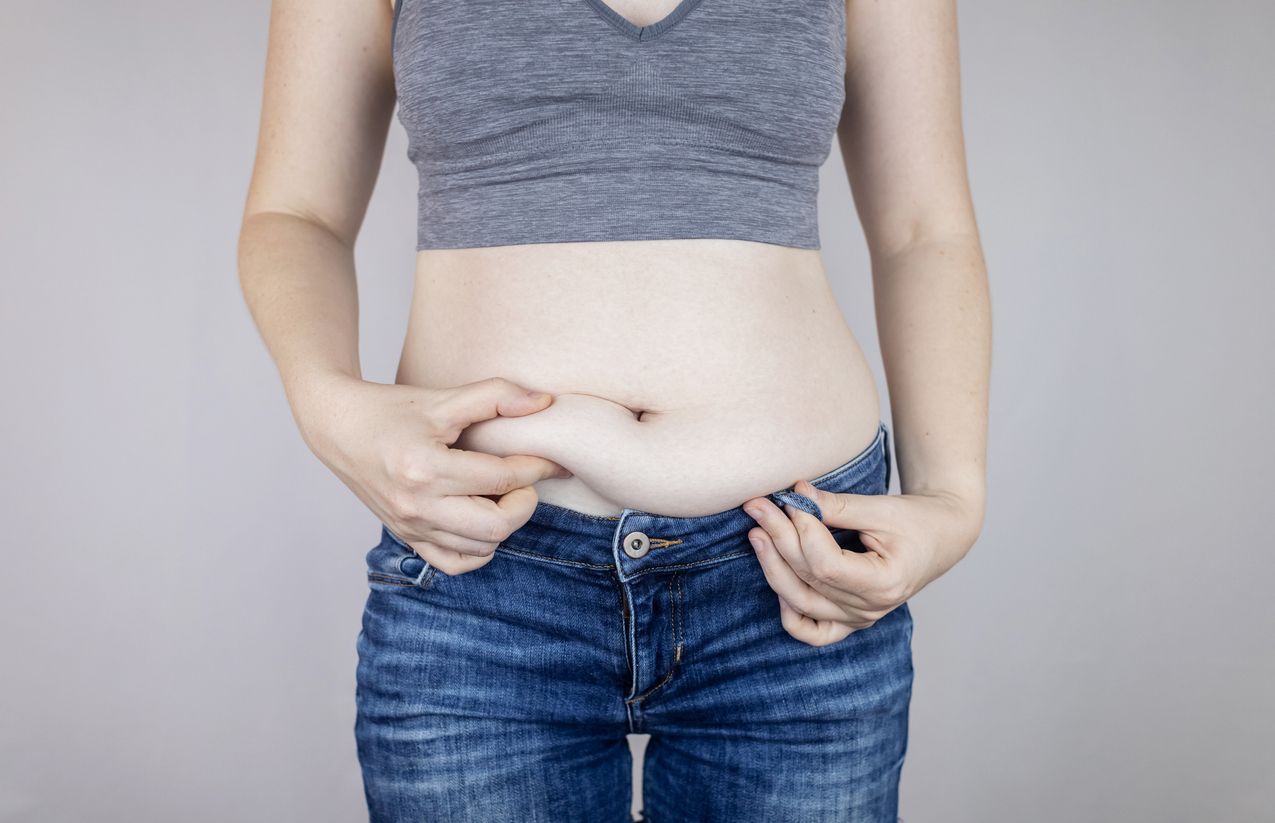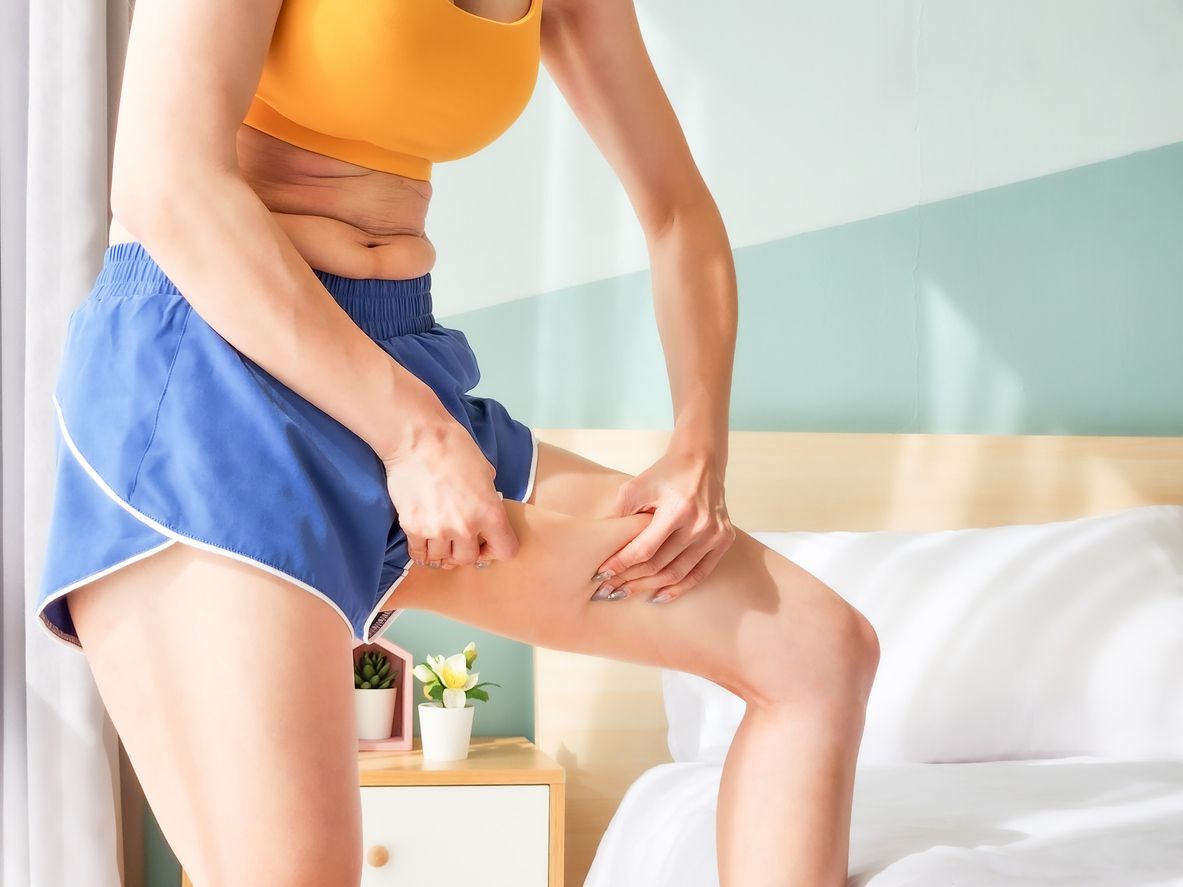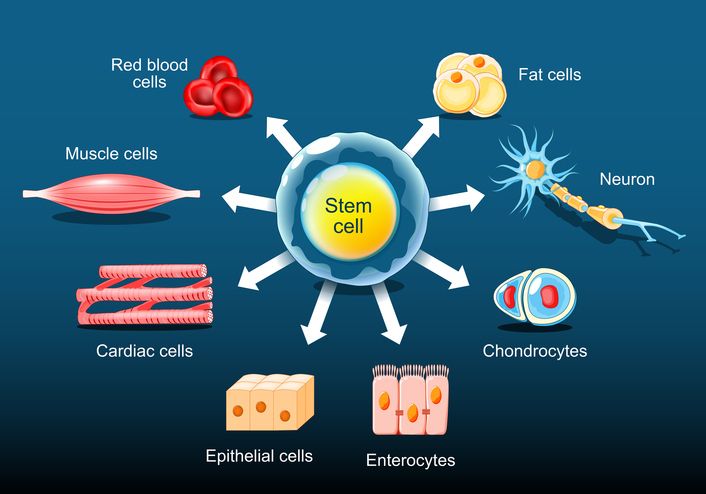
Author: Natalie Ng|Updated: 27 May 2025
Noticed the number on the scale suddenly go up? Or maybe your rings feel tighter, your stomach looks puffier, or your socks leave marks on your ankles. These changes can feel like weight gain—but they’re usually just water weight.

Sign Of Water Retention 1: Sudden Weight Fluctuations in a Few Days

Your body weight can shift fast
It’s common to see your weight change by a couple of pounds from one day to the next. These small fluctuations usually don’t mean you’ve gained fat. In most cases, your body is just holding onto more water.
A few common reasons for fluid retention include:
• Eating salty foods or a diet high in sodium
• Changes in physical activity, like starting or stopping exercise
• Hormonal fluctuations, especially during your menstrual cycle
• Increased carb intake, which pulls more water into your muscles
• Travel or long periods of sitting, which can cause swelling in your legs and feet
These changes can lead to temporary weight gain without affecting your body fat percentage or fat cells.
Track patterns to spot water weight
If your weight suddenly increases by 4 to 5 pounds and then drops again in a few days, you’re likely dealing with excess water weight. But if the gain is slower and sticks around, it could be caused by eating more calories than you burn, which leads to fat weight gain.
To tell the difference more clearly:
• Weigh yourself at the same time each morning, after using the bathroom and before eating or drinking
• Keep a daily log for at least a week to spot patterns
• Watch for sharp ups and downs, which point to water retention rather than fat gain

Sign Of Water Retention 2: Swollen Fingers and Tight Rings

Finger swelling that makes rings feel tighter
If your rings suddenly feel tighter or harder to remove, fluid retention may be to blame. This kind of swelling usually affects your fingers and can make jewelry feel uncomfortable or even painful.
Some common situations that can trigger water retention in your hands include:
• Hot weather, which causes blood vessels to expand
• Eating salty foods or meals high in sodium
• Drinking less water than usual throughout the day
• Hormonal fluctuations during your menstrual cycle or pregnancy
• Intense workouts that lead to temporary inflammation
• Sleeping with your hands below your heart
• Air travel or sitting still for long hours
• Certain medications or health conditions
These changes can cause excess fluid to collect in the tissues of your fingers, making them look and feel puffier than usual.
Quick ways to relieve tight rings
If your fingers are swollen and your rings feel snug, raising your hands above your heart while gently flexing your fingers for several minutes can help improve fluid circulation. You can also run your hand under cold water, then warm water, repeating this a few times to stimulate blood flow. Applying a thin layer of lotion or oil around the ring often makes removal easier. If needed, wrapping dental floss tightly from the fingertip down past the ring and then slowly unwinding it can help slide the ring off gently.
Book Now to Experience
S6 Body Sculpting Treatment
1 Minute Self-Registration
Date should not be before minimal date

Sign Of Water Retention 3: Sock Marks That Stick Around
Clothing indentations that don’t fade quickly
If you notice sock lines, bra marks, or waistband indentations staying on your skin for more than 20 to 30 minutes, you may be holding onto excess fluid. While pressure from clothing can leave temporary marks, persistent indentations often suggest water retention in the tissues under your skin — especially around your lower legs, ankles, and waist.
This kind of swelling can become more noticeable in the evening, particularly after long periods of sitting or standing. Fluid tends to settle in the lower body throughout the day due to gravity, making your legs and feet more prone to swelling.
Spotting the difference between normal and concerning marks
Temporary marks usually fade not long after removing the clothing or shoes that caused them. But if the impressions last for hours, or if you see swelling in just one leg, it's worth checking further. Gently press your finger into the skin of your lower leg — if a dimple stays for several seconds instead of springing back, this could be a sign of fluid buildup.
You may also want to note if you experience:
• Indentations that last well past clothing removal
• Swelling that is asymmetrical or paired with pain
• New or worsening puffiness around your feet and ankles

Sign Of Water Retention 4: Monthly Bloating From Hormonal Changes
Fluid shifts linked to your menstrual cycle
Many women notice bloating around their period. While it can feel like weight gain, this puffiness is usually caused by fluid retention, not fat. Hormonal changes throughout the cycle affect how your body manages fluids and can make you feel heavier, especially in your lower belly, face, or chest.
About a week before your period, estrogen levels begin to rise. This can lead to subtle shifts in how your body holds water. Progesterone, another hormone that peaks before menstruation, can slow digestion and cause bloating. You might also experience a dip in magnesium levels, which may contribute to fluid buildup.
What this means for your body weight
These monthly changes often show up as mild swelling, a softer stomach, or a temporary increase in body weight. It’s common to feel more bloated or see a small jump on the scale. These symptoms usually ease once your period starts and your hormones begin to level out again.
If you track your cycle, you may start to notice patterns. This can help you predict when you’re likely to feel bloated or retain more water, making it easier to tell the difference between temporary changes and fat gain.

Sign Of Water Retention 5: Changes After Eating Salty Foods
Fluid retention after high-sodium meals
If you’ve had a salty meal and notice puffier fingers, a fuller face, or swelling in your lower legs within hours, it’s likely your body is holding onto extra water. Sodium affects your fluid balance, and when you eat more than usual, your body responds by storing more water to maintain proper levels.
This kind of swelling can happen quickly — sometimes within just a couple of hours. Your body is trying to balance the salt in your system, and one way it does that is by pulling more water into your tissues.
How your body responds after a high-salt meal
These are some typical signs of water retention that follow salty meals:
• Finger swelling within 1–2 hours
• Puffiness in your face or under your eyes after 3–4 hours
• Swelling around the ankles or feet by the end of the day
• A general bloated feeling that may last into the next day
If you’re eating out or snacking on processed foods, you may not realize how much sodium you’re taking in. Drinking plenty of water and staying active after meals can help your body flush out the excess sodium and reduce water weight more quickly.
Book Now to Experience
S6 Body Sculpting Treatment
1 Minute Self-Registration
Date should not be before minimal date

Sign Of Water Retention 6: Morning vs Evening Weight Differences
Natural weight shifts throughout the day
It’s completely normal for your body weight to be lower in the morning and higher in the evening. This change usually ranges from 2 to 5 pounds and is mainly caused by fluid fluctuations, not fat gain.
After a night of sleep, your body is slightly dehydrated from hours of breathing and sweating. You’ve also gone several hours without food or drink, which lowers your weight temporarily. Once your day starts, eating, drinking, and being upright lead to more fluid retention and undigested food in your system — all of which reflect on the scale.
What affects your body weight from morning to night
Some common factors that contribute to daily weight increases:
• Meals and snacks eaten during the day
• Water and other fluids you’ve consumed
• Natural buildup of fluid from being upright for hours
• Food still being digested by the evening
• Hormonal changes or salty food intake
For the most accurate tracking, weigh yourself at the same time each morning — after using the bathroom and before eating or drinking. This helps you monitor true weight changes without being misled by normal water retention.

Sign Of Water Retention 7: Muscle Soreness After Exercise
Swelling linked to post-workout recovery
After a tough workout, your muscles may feel sore, tight, or slightly swollen — and this can show up as temporary weight gain. While it might seem like fluid retention, this increase isn’t caused by the same kind of water weight you get after a salty meal. It’s part of your body’s natural repair process.
When you exercise, especially with strength training or high-intensity movement, small tears form in your muscle fibers. Your body responds by sending more blood and fluid to the area to help with recovery. This can lead to short-term swelling that makes your muscles feel tender or puffy.
What you might notice after exercise
This reaction is often called DOMS (Delayed Onset Muscle Soreness) and usually peaks 24 to 48 hours after a workout. You might see:
• A small weight increase of 1 to 3 pounds
• Mild swelling around the worked muscle groups
• A tight or full feeling in your arms, legs, or core
This kind of weight gain is temporary and part of building strength. To help your body recover, drink plenty of water, stretch lightly, and give your muscles time to rest before your next session.

Sign Of Water Retention 8: Swelling After Long Travel
Body changes caused by sitting for long periods
If your feet feel tight in your shoes after a flight or your rings feel snug at the end of a long road trip, that’s a sign your body is holding extra fluid. Travel often leads to temporary water retention, especially in your lower legs, ankles, and hands.
Sitting still for hours slows circulation. Gravity pulls fluid down into your lower body, where it builds up in the tissues. Air pressure changes during flights, salty snacks, and dehydration from dry cabin air or irregular drinking habits all add to the effect.
What travel-related water retention feels like
Common signs of fluid buildup during or after travel include:
• Puffy feet or ankles that make shoes feel tight
• Swollen fingers or hands after several hours in a seat
• Mild bloating or a heavier feeling in the lower body
These changes are temporary and usually ease within a day or two. To help reduce water retention while traveling, drink plenty of water, avoid salty snacks, move around every hour if you can, and consider wearing compression socks on longer trips.
Book Now to Experience
S6 Body Sculpting Treatment
1 Minute Self-Registration
Date should not be before minimal date

Sign Of Water Retention 9: Sudden Weight Gain After Eating More Carbs
Water weight linked to increased carbohydrate intake
If you’ve recently started eating more carbs — whether it’s pasta, bread, rice, or fruit — you might notice a quick jump on the scale. This doesn’t mean you’ve gained fat. Carbohydrates are stored in your muscles and liver as glycogen, and for every gram of glycogen, your body holds on to about 3 to 4 grams of water.
That extra water can add a few pounds almost overnight, especially if you’ve shifted from a low-carb diet or just finished a period of eating fewer calories. Your body is simply refueling and rehydrating at the same time.
What this looks like in your body
You might notice:
• Your weight increases by 2 to 5 pounds within a couple of days
• Your muscles feel fuller or tighter, especially in your arms and legs
• Your clothes fit more snugly, even though your eating hasn’t drastically changed
This response is normal, and not a sign of fat gain. If you want to check how carbs affect your body weight, try tracking your intake for a few days and pay attention to how your body feels. These shifts are part of how your body stores and uses energy — not changes in body fat.

How to Tell the Difference Between Water Retention and Fat Gain
Key differences in how they show up in your body
It’s easy to confuse temporary water weight with actual fat gain — especially when the scale moves quickly. But your body gives you clues that help you figure out which one you're dealing with.
Here’s how to tell them apart:
• Water weight changes quickly — You might gain or lose 2 to 5 pounds in a day or two. Fat gain happens slowly, over time.
• Swelling is usually soft and even — Fluid retention tends to cause puffiness in the fingers, face, stomach, or ankles. Fat feels firmer and settles in areas like the hips, thighs, and belly.
• Scale fluctuations reverse fast — If your weight jumps after a salty meal or travel, then drops after a day or two of drinking more water or moving around, that’s water — not fat.
• Fat gain often comes with a change in habits — A pattern of eating more calories, reduced physical activity, or long-term hormonal changes can lead to fat storage.
By paying attention to these patterns, you can avoid panicking over normal changes and better track your progress toward weight loss or body goals.

How to Reduce Water Retention Safely and Naturally
Everyday habits that help your body release excess fluid
If you’re noticing signs of water retention, there are simple steps you can take to help your body release that extra fluid. These habits don’t require drastic changes — just small adjustments that support your body’s natural balance.
Here’s what can help:
• Drink plenty of water
It may seem counterintuitive, but staying hydrated tells your body it doesn’t need to hold onto fluid. Aim for 8 to 10 glasses per day, and more if you’re active or in hot weather.
• Reduce salt intake
Eating less sodium helps prevent fluid buildup in your tissues. Avoid heavily processed foods and go lighter on salty meals, especially before bed.
• Move your body regularly
Physical activity helps stimulate circulation and lymphatic flow, both of which help reduce water weight. Even light walking or stretching can make a difference.
• Include potassium-rich foods
Foods like bananas, spinach, sweet potatoes, and avocados support fluid balance and help flush out excess sodium.
• Support hormonal balance
If your water retention tends to follow your menstrual cycle, track your symptoms and avoid added salt during the days you usually feel bloated.
• Try natural diuretics
Herbal teas like dandelion root may gently help the body release fluid. Speak with a registered dietitian if you’re considering supplements or herbal remedies.
• Avoid dehydration triggers
Caffeine and alcohol can increase dehydration, leading to more water retention. Space them out with water to help maintain balance.
Book Now to Experience
S6 Body Sculpting Treatment
1 Minute Self-Registration
Date should not be before minimal date

Support Your Fat Loss Goals with S6 Body Sculpting Treatment
When it’s not just water weight
If your weight doesn’t bounce back after a few days, and bloating isn’t the issue, you may be looking at fat gain, not water retention. While excess fluid often comes and goes with changes in salt intake or hormones, body fat builds up gradually — especially in areas like the belly, thighs, and lower back. These fat deposits tend to stay even after water weight is gone.
This is where S6 Body Sculpting Treatment can help.
What is S6 Body Sculpting?
S6 is a non-invasive fat reduction treatment designed to target stubborn fat cells in specific areas of the body. It uses a low-energy bio-laser that penetrates deep into subcutaneous fat tissue, breaking down fat cells and releasing fatty acids for lymphatic drainage. A built-in vacuum suction system helps stimulate metabolism and supports the body’s natural ability to process and eliminate this released fat.
At the same time, the treatment encourages collagen production, which firms and tightens the skin — helping improve tone in areas that have lost volume or shape.
How it supports your body transformation
• Helps reduce fat weight in areas not affected by fluid changes
• Complements efforts to manage water retention vs fat gain more clearly
• No surgery or downtime — walk in, walk out
• Boosts metabolism and promotes faster removal of broken-down fat
• Targets fat in the belly, arms, thighs, calves, waist, back, and under the buttocks
• Tightens skin while reducing volume
If you’ve already tackled water retention but still notice changes in body weight or body fat percentage, this treatment can help bridge the gap between how you feel and how you want to look.
Book your consultation today and see how S6 Body Sculpting can support your fat loss goals — beyond water weight.
S6 Body Sculpting TreatmentBook Now to Experience
S6 Body Sculpting Treatment
1 Minute Self-Registration
Date should not be before minimal date
FAQ
1. Can stress cause water retention or fat gain?
Yes. Stress can impact both water retention and fat gain, but in different ways. High stress levels increase cortisol, a hormone that can lead to temporary fluid retention and long-term fat storage, especially around the stomach. When stress is ongoing, it can also lead to behaviors like eating more calories or sleeping less, which contribute to fat weight over time.
2. Does eating sugar cause water retention?
Eating large amounts of sugar can lead to temporary water retention. This happens because sugar increases insulin levels, which tells your kidneys to hold onto more sodium — and that extra sodium causes the body to retain more water. A diet high in sugar and salt can make you feel bloated and cause the scale to spike, even if it’s not true fat gain.
3. How long does water weight usually last?
Water weight can last anywhere from a few hours to a few days, depending on the cause. For example, water retained after a salty meal may go away within 24 to 48 hours if you drink plenty of water and move your body. In contrast, fluid retention from hormonal fluctuations may last several days, especially around the menstrual cycle. Tracking your body weight regularly can help you spot patterns and understand how long these fluctuations last for you.
4. Can dehydration make my body hold onto fat?
Dehydration doesn’t directly cause fat gain, but it can slow down fat loss. When you're not drinking enough water, your metabolism may become less efficient, which affects how your body burns fat for energy. Dehydration can also make you feel hungrier and more tired, which may lead to eating more calories and moving less — both of which contribute to long-term fat weight gain.
5. Is it possible to reduce water weight without losing muscle?
Yes. You can reduce water weight without losing muscle by focusing on hydration, reducing salt and sugar intake, and maintaining regular physical activity. Unlike fat or muscle, excess fluid can be flushed out relatively quickly. Staying hydrated and eating enough protein while managing sodium intake supports your muscles while helping reduce fluid retention.
Recommended Articles
COPYRIGHT© NEW BEAUTY MANAGEMENT LIMITED 2025. ALL RIGHT RESERVED.




